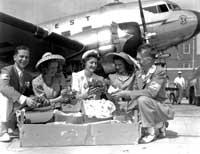Trading Cars for Airplanes
In 1914, Snelling Speedway sat where the Minneapolis-St. Paul International Airport (MSP) operates today. The auto-racing venue was unsuccessful, and the Minneapolis Aero Club acquired the property for loftier purposes. The first hangar, a wooden structure, was constructed in 1920 to accommodate airmail service, and the 160-acre property became known as Speedway Field. In 1923, the airport was renamed Wold-Chamberlain Field in honor of two local pilots, Ernest Wold and Cyrus Chamberlain, who lost their lives in combat during World War I.
The airport soon became home to Northwest Airways, which in 1926 won the government's airmail contract and acquired the airport's only hangar.
Progress
In its 80-year history, MSP has undergone numerous changes, from its first landing strip in 1920, to its first passenger service in 1929 and massive expansion efforts in the early 1960s, including construction of the Lindbergh Terminal (now Terminal 1), a maintenance base and Northwest Airlines' world headquarters.
With the arrival of international service, MSP underwent its final name change in 1948, becoming Minneapolis-St. Paul International Airport.
In 1958, ground breaking ceremonies were held for the terminal, which opened to the public in 1962. It was designed to serve four million passengers a year by 1975. Passenger growth far exceeded projections, however, with more than 4.1 million people using the airport by 1967.
Passenger growth continued to exceed expectations in the 1970s and 1980s. To address this growth, the Minnesota legislature passed the Metropolitan Airport Planning Act in 1989, establishing the Dual Track Airport Planning Process. Conducted by the Metropolitan Airports Commission (MAC) and the Metropolitan Council, the seven-year planning process explored options for providing needed air service capacity and facilities for the region.
Specifically, competing plans were developed to either expand MSP at its present site or build a new airport elsewhere.
The Next Generation
Upon completion of the study in 1996, the Minnesota Legislature directed the MAC to implement the MSP 2010 Long-Term Comprehensive Plan, providing for $3.1 billion in airport improvements at the current site.
Virtually every aspect of MSP has been transformed in the years since, with a major expansion of Terminal 1, a new Terminal 2, expanded roadways and parking, two automated airport trams, and development of a light-rail system connecting both MSP terminals to the Mall of America and the downtowns of Minneapolis and St. Paul.
With the final major aspect of the 2010 program, a new fourth runway, having opened in October 2005, the MAC is now implementing improvements identified through its 2030 Long-Term Comprehensive Plan.

